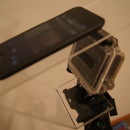Introduction: Convert a Servo to Switch on and Off LED's
One of the most common parts in remote control electronics is the servo. They offer proportional movement using a potentiometer, gears, a motor and an H Bridge Circuit. What we will be doing is taking apart a tiny servo to remove the circuit and potentiometer. We will then de-solder the motor and solder wires in it's place. These wires will then go to LEDs to light them up.
One interesting part about LEDs is that they are diodes (Light emitting diodes) so electricity will only flow through them one way. Based on this principle when we attach them to where the motor was, when the motor would be spinning one way, the electricity flows one way and will light up the LED. When you flip a switch on your transmitter it would make the motor spin the other way which makes electricity flow the other way but it can't becasue the LED won't allow it through the other direction. This essentially turns off the light. When paired up (the + of one LED to the - of the other and vice versa) when the motor spins one way, one LED lights up, flip the switch and that one turns off and the other turns on. This is what we will be making
Step 1: Take Apart the Servo
First you need to extract the necessary pieces. Remove the 2-4 screws to pull the bottom of the casing off, then pull the top off. Remove the gears as we will not need them. Then remove the potentiometer (It will have 3 pins and likely be what the main shaft of the servo rotates on. I had to cut my case to get it out without de-soldering the leads. You will then de-solder the motor and put it in your junk pile for some other project.
Step 2: Prepare and Solder Your Interface Wires
I chose to put breadboarding leads on so I can experiment, however you can put on wires straight to the LEDs if you know your exact layout ahead of time. I cut the breadboard hookup wire in half so I was only killing 1 lead. Then I soldered each half on where the motor leads were. This will allow easy interfacing and prototyping. The Diagram below shows how the circuit works, note the position of the dial on the red servo tester. When centered (if the potentiometer is centered) neither light should come on. When turned one way, one color should turn on, when turned the other way the other color turns on.
Step 3: Heat Shrink Time
You could easily use hot glue but it is harder to get back into the circuit if a wire comes out. I prefer heat shrink tubing. I put two layers around the circuit (so that when I put the potentiometer on it wouldn't poke through to the circuit). I then placed the potentiometer on top and slid a piece of heat shrink with a hole for the potentiometer shaft, shrinking each piece before putting on the next.
Step 4: Done!
VOTE FOR ME IN THE "UP! Contest"
https://www.instructables.com/contest/up2013/?show=ENTRIES
VOTE FOR ME IN THE "Instructables Design Contest"
https://www.instructables.com/contest/design2012/?show=ENTRIES
Showing it on auto (sweeping) with the servo to show what the commands going to the circuit look like.

Participated in the
Instructables Design Competition

Participated in the
UP! Contest













